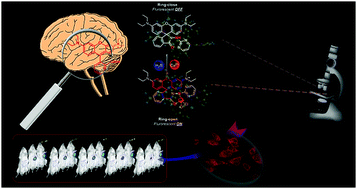An efficient biosensor for monitoring Alzheimer's disease risk factors: modulation and disaggregation of the Aβ aggregation process†
Abstract
Alzheimer's disease (AD) is a progressive neurodegenerative disease, which can lead to the complete loss of cognition. Cu2+ and H2S are both correlated with the physiological and pathological events of AD. Therefore, suitable methods to continuously monitor Cu2+ and H2S are in great demand for a better understanding of the detailed mechanism of Alzheimer's disease. Based on the heteroatom (N, O, and S) competitive effect, a series of reversible “off–on–off” fluorescent probes, S1–S3, for the detection of Cu2+ and H2S was designed and synthesized, which contain different alkaloids as acceptors. Their mechanism is demonstrated via IR spectroscopy, Job plot analysis and DFT calculation. These three compounds exhibited high selectivity and sensitivity (limit of detection = 1.95 nM, 1.51 nM, and 6.62 nM, respectively) for Cu2+ with a fast response rate. In addition, S1 exhibited extremely low cytotoxicity and superb membrane permeability, which could be applied in living MCF-7 cells and living mice to monitor Cu2+ under physiological conditions. Importantly, the excellent chelation of the S1 probe for Cu2+ was effectively utilized to capture Cu2+ from the aggregation of Aβ, which was observed experimentally via ThT fluorescence, transmission electron microscopy (TEM), and native polyacrylamide gel electrophoresis (native-PAGE).



 Please wait while we load your content...
Please wait while we load your content...